Krishnanattam
.jpg)
Krishnanattam (Malayalam: കൃഷ്ണനാട്ടം, IAST: Kṛṣṇanāṭṭaṃ) or Krishnattam is a temple art in Kerala, India. It is a dance drama and presents the story of Krishna in a series of eight plays and was created by Manaveda (1585–1658 AD), the then Zamorin Raja of Calicut in northern Kerala.[1] The eight plays are: Avataram, Kaliyamardanam, Rasakrida, Kamsavadham, Swayamvaram, Banayuddham, Vividavadham and Swargarohanam.[2] It survives in its glory at the Guruvayur Sri Krishna temple (Thrissur district, Kerala, India). The troupe of players,once maintained by Zamorin of Calicut came to Guruvayur Devaswom.[3] in 1958.The only troupe of artists are well maintained by devaswom till date.
Origin
Krishnanattam is based on Krishnagiti (1654 AD) written by Manaveda, Zamorin of Calicut.[4] It is believed that the Zamorin had a vision of Krishna who gave the king a peacock feather, which became the living symbol of this dance-drama. Krishnanattam players wore a peacock feather and thus commemorated the vision of the chieftain.[5]
The legend
King Manaveda told Vilwamangalam about his ambition to view Krishna. The next day the Swamiyar told him that Guruvayurappan has given his consent and Manaveda can see Guruvayurappan playing in the early hours of the morning at the platform of the Elanji tree.[6] He could only see and not touch Him.When as per this agreement, Manaveda saw Guruvayurappan in the form of little child Sri Krishna, he was so excited that he forgot himself and, rushed to embrace little Sree Krishna.Guruvayoorappan immediately disappeared saying, "Vilwamangalam did not tell me that this will happen ".However, Manaveda got one peacock feather from the head gear of Bhagavan Krishna.[7]
The peacock feather was incorporated in the headgear for the character of Sri Krishna in the dance drama Krishnanattam based on his own text krishnageeti which is composed of 8 chapters . It was performed near the sanctum sanctorum of the Guruvayur Temple. On the ninth day, Avatharam was repeated as the Zamorin felt that it was not auspicious to end the series with the demise of Lord Krishna.[8] The blessed art form is still maintained by Guruvayur devaswom and staged as an offering by devotees.[9]

Author
(1585–1658 AD) had education from Anayath Krishna pisharody and Desamangalath varrier. He wrote Poorva bharatha champu(sanskrit) in 1643.[10] He completed Krishnanattam on 16 November 1653 aged[11] His statue was installed near 'Panjajanyam' geust house in Guruvayur.
Krishnageethi
The Sanskrit text based on which Krishnanattam was created was written on A.D 1653,aged 68.[12] It consists of eight plays-Avataram, Kaliyamardanam, Rasakrida, Kamsavadham, Swayamvaram, Banayuddham, Vividavadham and Swargarohanam.It is based on 10th and 11th skandhas of Bhagavata Purana dealing solely the story of Krishna.[13] It has also gained inspirations from Gita Govinda of Jayadeva, Sree krishna vilaasam mahakavya and Narayaniyam of Melpathur Narayana Bhattathiri.[14]
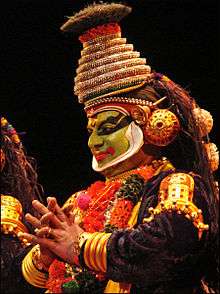

Opening sloka of Krishnanattam is-
Jagathi sukritilokai: nandithaananthidaasa
Kalaviranithavamsiibhasamanaasamana|
Pashupayuvathibhogya devathaadevathaa saa
Sajalajaladhapaliimechaka me chakaasthu||[11]
Apart from such slokas it is also adorned by many padyageethams like that of Gita Govinda of Jayadeva.Krishnagiti is a masterpiece work in sanskrit by a keralite.
The stories

The eight plays are: Avataram, Kaliyamardanam, Rasakrida, Kamsavadham, Swayamvaram, Banayuddham, Vividavadham and Swargarohanam.[15] its easily memorised by a mnemonic "a-ka-ra-ka-swa-bha-vi-swa".On the ninth day, Avatharam is repeated.[16]
The various benefits of Krishnanattam as an offering are listed here.
1)Avatharam for a birth of a child.
2)Kaliyamardhanam to remove the effect of poison.
3)Rasakreeda well being of unmarried girls, to end disputes between couples.
4)Kamsavaddham to remove enemies.
5)Swayamvaram for a happy matrimony.
6)Bana yuddham to remove impoverishment, for good farm production.
7)Vividha vadham to eliminate poverty and increase yield from farms.
8)Swargarohanam for peace of a departed soul. .[17]
Costumes, Makeup and related Rituals
All four aspects of a drama,as told by Bharata Muni-viz,Angika, Vachika, Aharya and Satvika are well coordinated in it.
The teachers and artists themselves made the costumes.[18] The basic costume differed for male and female characters. The dress of male characters consisted of (1) a starched gathered petticoat (2) a gathered white skirt with orange/orange-red and black horizontal stripes near the bottom (3) bells attached to leather pads to tie below the knees (4) a long-sleeved shirt open at the back, secured by ties. (5) a breast-plate (6) chest ornaments of beads and fresh flora (7) a girdle (8) upper arm and wrist ornaments (9) one shawl or more with a mirror at each end; (10) ear and forehead ornaments; and (11) a headdress.[19]
For the female characters the basic costume included (1) a long, almost floor-length white gathered skirt with red border, wrapped so that the material crossed in the back (2) a long sleeved blouse which was open in the back, secured by ties; (3) a girdle (4) arm ornaments; (5) a wooden breast plate with the breasts covered in red cloth and with ornamentation above and below the breasts . Female characters tie strings of bells around their ankles. These are called chilanka.[20]
The actors used any or three colours for their basic make-up. (1) pazhuppu, an orange with more red than yellow (2) minukku, an orange with more yellow than red. (3) Paccha, a particular shade of green which has more yellow than blue. If he was to wear a chutti the chutti artist applies it. The chutti was two white protruding borders which extended from ear to ear along the jaw and chin line.[21]
The green for Krishna as a young child has more yellow than blue. Before applying make-up the actor prostrated himself before the oil lamp and thought of the God Guruvayoorappan.[22]
The most sacred part of the Krishnanattam costume is the head gear.[23] There are two basic kinds of head dress; a mudi, 'hair that has been wound into a bun and a kiriitam 'a crown'.[24]
Training
Training for artists starts as early as 10 years for 'vesham' and music,5 years for Madhalam and chutti.[25] Oil massage and sternous exercises makes an artist well enough to perform on stage.[22]
Performances
Night performances in Guruvayur temple in north to Lord Guruvayurappan occurs as offering by devotees.Apart from performing all over India, its reaches are spanning over Europe and America. Europe-1980;U.S.A-1985.,[26] Singapore, Paris..
Present setup
Consists of over 70 employees under Guruvayur Devaswom.Bookings have to be done through Devaswom alone,the rates for one kadha inside the guruvayur temple is rs.2000.[27]
Gallery
- Krishnanattam(കൃഷ്ണനാട്ടം)
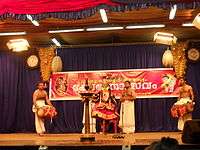
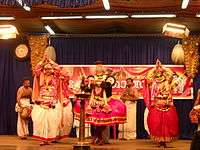

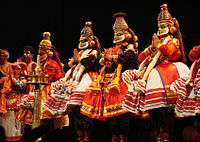
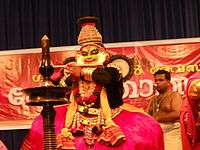 കൃഷ്ണനാട്ടം_.jpg
കൃഷ്ണനാട്ടം_.jpg
References
- ↑ http://www.chintha.com/kerala/krishnanattam-history-origin.html
- ↑ Comprehenseive Study of Indian Folk Music and Culture, Volume 11,page 228
- ↑ http://guruvayurdevaswom.nic.in/krattam.html
- ↑ History of Indian theatre ,vol 1,page 93
- ↑ The Contribution of Kerala to Sanskrit Literature ,K. Kunjunni Raja - 1980,page 99
- ↑ http://sangeethasabha.blogspot.in/2010/08/manavedans-krishnageethi-story.html
- ↑ .
- ↑ Bhavan's journal ,vol 33,page 97
- ↑ https://books.google.com/books?id=KYLpvaKJIMEC&pg=PA317&lpg=PA317&dq=Krishnanattam&source=bl&ots=uFrvPA7_mL&sig=mJYxmPjdVMTSnhoXj25qkOYFYoA&hl=en&sa=X&ei=L74pUcwMhdatB8ONgMgL&ved=0CDwQ6AEwAzhu#v=onepage&q=Krishnanattam&f=false
- ↑ Krsngitih of Manaveda,Indira Gandhi National Center for Arts, page 56
- 1 2 http://www.malayalamresourcecentre.org/Mrc/culture/artforms/krishnanaattam/krishnanaattam.html
- ↑ Martin Banham - 1995,The Cambridge Guide to Theatre, page 614
- ↑ Martha Bush Ashton-Sikora, Robert Peter Sikora,Krishnattam, page 201
- ↑ http://www.guruvayur.com/Krishnanattam.htm
- ↑ http://kerala.me/art_krishnanaattam.php
- ↑ Journal of South Asian Literature.Vol 10(1997),page 65
- ↑ http://www.guruvayuronline.com/index.php/temple/temple-offerings/special-offerings/179-krishnanattam
- ↑ Medieval Indian Literature: Surveys and selections By Ayyappappanikkar, page -223https://books.google.com/books?id=KYLpvaKJIMEC&pg=PA317&dq=manaveda&hl=ml&sa=X&ved=0CDQQ6AEwBDgKahUKEwjV4e-r6drIAhWCcY4KHTQtA44#v=onepage&q=manaveda&f=false
- ↑ http://www.justkerala.in/culture/kerala-dance-forms/krishnanattam
- ↑ http://www.planetsinfolab.com/horizonguruvayur.com/krishnanattam.html
- ↑ Annals of Oriental Research, Volume 12,University of Madras, page 223-229
- 1 2 https://books.google.com/books?id=KRz5ykKRVAEC&pg=PA109&lpg=PA109&dq=Krishnanattam&source=bl&ots=QmYCmh4NWk&sig=B5HTS2qrViOjypMNOswO7ehWhWI&hl=en&sa=X&ei=3rwpUZy5LYPprQe62IHADQ&ved=0CCwQ6AEwADha#v=onepage&q=Krishnanattam&f=false
- ↑ A panorama of Indian dances,Yu. Es Kr̥ṣṇarāv, Yu. Ke Candrabhāgādēvi,1983,page 43
- ↑ http://www.harekrsna.com/sun/features/12-09/features1569.htm
- ↑ http://www.traveladda.com › South india › Kerala › Dance and music
- ↑ http://indianastro.indianclassicals.com/krishnanattam.htm
- ↑ http://www.thehindu.com/todays-paper/tp-features/tp-metroplus/krishnanattam/article4036428.ece?css=print*
External links
| Wikimedia Commons has media related to Krishnanattam. |